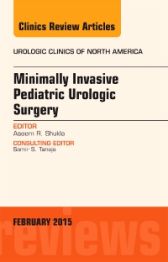Minimally Invasive Pediatric Urologic Surgery, An Issue of Urologic Clinics, 1st Edition
Author :
Aseem R. Shukla
Urologists were early adaptors of robotic assisted laparoscopy, and pediatric urology similarly led in incorporating the technology into the surgical armamentarium for treating even the smallest infants. And it is in that tradition that this issue o
...view more
Urologists were early adaptors of robotic assisted laparoscopy, and pediatric urology similarly led in incorporating the technology into the surgical armamentarium for treating even the smallest infants. And it is in that tradition that this issue of Urologic Clinics of North America surveys the journey from the earliest pure laparoscopic procedures to the most advanced reconstruction possible today due to evolutions in technology. The issue begins with the procedure that arguably popularized the laparoscopic approach in pediatric urology—the laparoscopic orchiopexy, then posit the continued relevance of pure laparoscopy in the robotic era, before finally surveying contemporary advances in robotic-assisted pediatric urologic surgery. The issue is of relevance not only tor the novice contemplating a transition to laparoscopy or robotics but also for the seasoned minimally invasive surgeon seeking to enhance skills and augment his or her practice.
Your discount code here : #FB456
Urologists were early adaptors of robotic assisted laparoscopy, and pediatric urology similarly led in incorporating the technology into the surgical armamentarium for treating even the smallest infants. And it is in that tradition that this issue of Urologic Clinics of North America surveys the journey from the earliest pure laparoscopic procedures to the most advanced reconstruction possible today due to evolutions in technology. The issue begins with the procedure that arguably popularized the laparoscopic approach in pediatric urology—the laparoscopic orchiopexy, then posit the continued relevance of pure laparoscopy in the robotic era, before finally surveying contemporary advances in robotic-assisted pediatric urologic surgery. The issue is of relevance not only tor the novice contemplating a transition to laparoscopy or robotics but also for the seasoned minimally invasive surgeon seeking to enhance skills and augment his or her practice.
Author Information
By Aseem R. Shukla, MD, University of Pennsylvania, Philadelphia, PA
| ISBN Number | 9780323354530 |
|---|---|
| Main Author | By Aseem R. Shukla, MD |
| Copyright Year | 2015 |
| Edition Number | 1 |
| Format | Book |
| Trim | Other |
| Imprint | Elsevier |
| Page Count | 0 |
| Publication Date | 1 Dec 2014 |
| Stock Status | IN STOCK - This may take up to 5 business days to ship |
Write Your Own Review
Only registered users can write reviews. Please sign in or create an account
product
https://www.us.elsevierhealth.com/minimally-invasive-pediatric-urologic-surgery-an-issue-of-urologic-clinics-9780323354530.html
1520
Minimally Invasive Pediatric Urologic Surgery, An Issue of Urologic Clinics
https://www.us.elsevierhealth.com/media/catalog/product/9/7/9780323354530.jpg
69.29
98.99
USD
InStock
/Medicine/Urology
/Clinics
/Clinics
128
4388725
5255041
1
3
8
4182692
5145120
Urologists were early adaptors of robotic assisted laparoscopy, and pediatric urology similarly led in incorporating the technology into the surgical armamentarium for treating even the smallest infants. And it is in that tradition that this issue of Urologic Clinics of North America surveys the journey from the earliest pure laparoscopic procedures to the most advanced reconstruction possible today due to evolutions in technology. The issue begins with the procedure that arguably popularized the laparoscopic approach in pediatric urology—the laparoscopic orchiopexy, then posit the continued relevance of pure laparoscopy in the robotic era, before finally surveying contemporary advances in robotic-assisted pediatric urologic surgery. The issue is of relevance not only tor the novice contemplating a transition to laparoscopy or robotics but also for the seasoned minimally invasive surgeon seeking to enhance skills and augment his or her practice. Urologists were early adaptors of robotic assisted laparoscopy, and pediatric urology similarly led in incorporating the technology into the surgical armamentarium for treating even the smallest infants. And it is in that tradition that this issue of Urologic Clinics of North America surveys the journey from the earliest pure laparoscopic procedures to the most advanced reconstruction possible today due to evolutions in technology. The issue begins with the procedure that arguably popularized the laparoscopic approach in pediatric urology—the laparoscopic orchiopexy, then posit the continued relevance of pure laparoscopy in the robotic era, before finally surveying contemporary advances in robotic-assisted pediatric urologic surgery. The issue is of relevance not only tor the novice contemplating a transition to laparoscopy or robotics but also for the seasoned minimally invasive surgeon seeking to enhance skills and augment his or her practice.
0
0
add-to-cart
9780323354530
2014
Professional
By Aseem R. Shukla, MD
2015
1
Book
Other
Elsevier
0
Dec 1, 2014
IN STOCK - This may take up to 5 business days to ship
By <STRONG>Aseem R. Shukla</STRONG>, MD, University of Pennsylvania, Philadelphia, PA
Clinics
Clinics
The Clinics: Internal Medicine
No
No
No
No
Please Select
Please Select
Please Select
Related Products
-
35% OFF
 Book
Book
-
35% OFF
 Flash Cards
Flash Cards
-
35% OFF
 Flash Cards
Flash Cards
-
35% OFF
 Book
Book
-
35% OFF
 Book
Book
-
35% OFF
 Flash Cards
Flash Cards
-
30% OFF
 Book
Nolte's The Human Brain in Photographs and Diagrams
Book
Nolte's The Human Brain in Photographs and DiagramsTodd W. Vanderah
Jan 2019
Special Price $44.79 $63.99 -
30% OFF
 Book
Book
-
35% OFF
 Book
Book
-
35% OFF
 Online Resource
Netter's Dissection Video Modules (Retail Access Card)
Online Resource
Netter's Dissection Video Modules (Retail Access Card)University of North Carolina Chapel Hill and Frank H. Netter
Oct 2015
Special Price $117.64 $180.99




